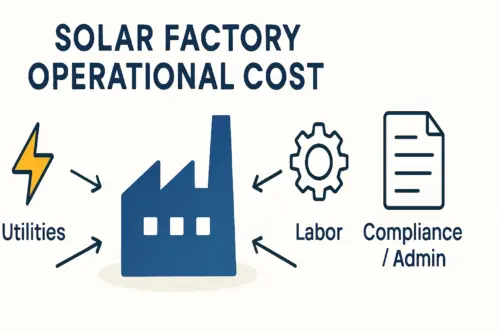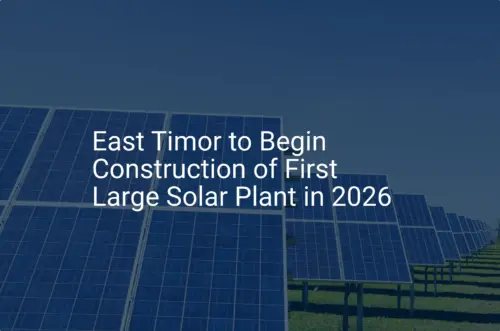The most compelling business opportunities often arise from solving a fundamental economic imbalance. Consider East Timor: a nation gifted with abundant sunshine, yet heavily reliant on expensive, imported diesel fuel for its electricity. This paradox presents a clear and significant opening for investment in local solar module manufacturing.
This analysis explores the primary forces driving demand for solar photovoltaic (PV) modules in East Timor. It is designed for business professionals and investors who recognize the potential of renewable energy but may be unfamiliar with the region’s specific market dynamics.
We will examine government initiatives, private sector needs, and the unique advantages local production offers.
The Foundation: East Timor’s Energy Landscape
To appreciate the scale of this opportunity, it is essential to first understand the country’s current energy situation. The national grid runs predominantly on diesel generators, a reliance that creates two major challenges for the economy:
-
High Cost of Electricity: Diesel fuel is imported, making it subject to volatile global prices. This results in electricity tariffs that are among the highest in the region, often ranging from $0.14 to $0.25 per kWh and suppressing economic activity for both businesses and households.
-
Grid Instability: In many areas outside the capital, Dili, the power supply can be unreliable, leading to frequent outages that disrupt commercial operations and daily life.
East Timor, however, boasts a world-class solar resource. The country experiences an average solar irradiation of 5.5 kWh/m²/day, making it an ideal location for photovoltaic technology. This abundant, free “fuel” source is the natural solution to the nation’s energy challenges.

Driver 1: Government-Led National Electrification
A primary catalyst for solar demand is the government’s strategic vision, outlined in the Timor-Leste National Electrification Plan (NEP). This ambitious policy aims to provide 100% of the population with access to electricity by 2030, with a strong emphasis on renewable sources.
Currently, national electricity access stands at approximately 81%, leaving a significant portion of the rural population without reliable power. Closing this gap is a national priority. For these remote communities, extending the central grid is often economically unfeasible. As a result, decentralized solar solutions—such as local mini-grids and standalone systems—are the most practical and cost-effective path forward.
Ready to make big Profits?
The solar Industry is Booming
WE HELP NEWCOMERS to the solar industry start their own solar module production line. Customers can make BIG PROFITS by selling modules and finding investors, without wasting money and time on things they don't need!

This government-led initiative creates a stable, long-term source of demand for solar modules. A local manufacturing facility would be ideally positioned to supply these national projects and contribute directly to the country’s development goals.
This push is also supported by international development partners like the Asian Development Bank (ADB), which provides financing and technical assistance, offering another layer of security for potential investors.
Driver 2: The Commercial and Industrial (C&I) Sector Imperative
Beyond government projects, the private sector represents a substantial and growing market. Businesses across East Timor—from agriculture and food processing to tourism and small-scale manufacturing—are hampered by high operational costs and unreliable energy.
For any C&I enterprise, energy is a direct input cost. When that cost is high and unpredictable, it erodes profitability and competitiveness. Solar PV offers these businesses a direct path to:
-
Cost Reduction: By generating their own power, businesses can drastically lower their electricity bills and insulate themselves from rising diesel prices.
-
Energy Independence: On-site solar generation provides a reliable power source, eliminating costly downtime caused by grid failures.
-
Predictable Expenses: A solar installation has a fixed upfront cost and minimal ongoing operational expenses, allowing for more accurate long-term financial planning.
The economic case is compelling. A local solar module manufacturer can serve this market by providing systems tailored to the specific needs of these businesses, helping to unlock greater productivity and economic growth across the country.

Driver 3: The Untapped Market for Decentralized Applications
The demand for solar in East Timor extends beyond large-scale electrification and industrial use. A significant, underserved market exists for smaller, decentralized applications that are critical for rural development. These include:
-
Solar Water Pumps: For irrigation in the agricultural sector, improving crop yields and food security.
-
Solar Home Systems: For individual households not yet connected to a mini-grid.
-
Power for Community Services: Ensuring reliable electricity for essential facilities like health clinics, schools, and communication towers.
A local factory can adapt its production lines to produce the specific module types required for these applications. This agility allows a local enterprise to serve market segments that large international suppliers, focused on bulk standardized products, may overlook. Planning a facility that can meet these diverse needs requires a detailed understanding of the required solar manufacturing equipment.
The Strategic Advantage of Local Production
An investor considering this market might ask: why not simply import modules? While importation is an option, establishing a local manufacturing facility offers distinct strategic advantages.
Based on experience from J.v.G. Technology GmbH turnkey projects, local production delivers tangible benefits:
-
Reduced Logistics Costs and Lead Times: Eliminates international shipping expenses and delays, ensuring a faster supply chain for critical projects.
-
Customization for Local Conditions: Modules can be designed to withstand the specific challenges of a tropical climate, such as high heat and humidity.
-
Alignment with Government Policy: Local manufacturing creates jobs and adds value to the domestic economy, making the enterprise a more attractive partner for public-sector contracts.
-
Improved Service and Support: A local presence allows for better after-sales service and technical support.
Developing a comprehensive solar module manufacturing business plan is the first step in capitalizing on these advantages. For those new to the industry, exploring a turnkey solar factory setup can provide a structured and efficient path to market entry.
Frequently Asked Questions (FAQ)
What is the typical investment for a small-scale solar module factory?
For an entry-level facility with an annual capacity of 20–50 MW, the initial investment in machinery and setup falls within a predictable range. A detailed financial model is necessary for an exact figure, but this scale is well-suited for an emerging market like East Timor.
Are there specific technical challenges for modules in a tropical climate?
Yes. High ambient temperatures can slightly reduce module efficiency, and high humidity requires robust junction boxes, sealants, and frame designs to prevent moisture ingress and corrosion over the module’s 25-year lifespan.
How can a local factory compete with low-cost module imports?
Competition is not based solely on price per watt. A local manufacturer competes on logistics (lower transport costs, no import tariffs), customization, faster delivery times, local service, and by meeting government requirements for local content in national projects.
What core skills are needed to operate a solar module production line?
A production line requires a mix of personnel, including machine operators, quality control technicians, maintenance engineers, and a plant manager. Many operational skills can be taught through structured training programs provided by the equipment supplier.
Conclusion and Next Steps
The demand for solar modules in East Timor is not speculative; it is driven by fundamental economic and developmental needs. The convergence of government policy, the pressing requirements of the commercial sector, and the vast potential for off-grid applications creates a robust and sustainable market.
For the forward-thinking entrepreneur, this is an opportunity to build a profitable enterprise that also contributes directly to the nation’s energy independence and economic progress. The next logical step for anyone seriously considering this venture is to deepen their understanding of the technical and financial requirements for setting up a production facility.






